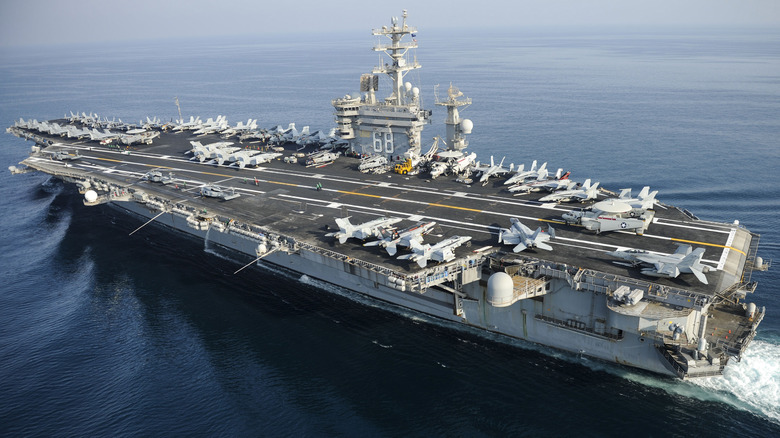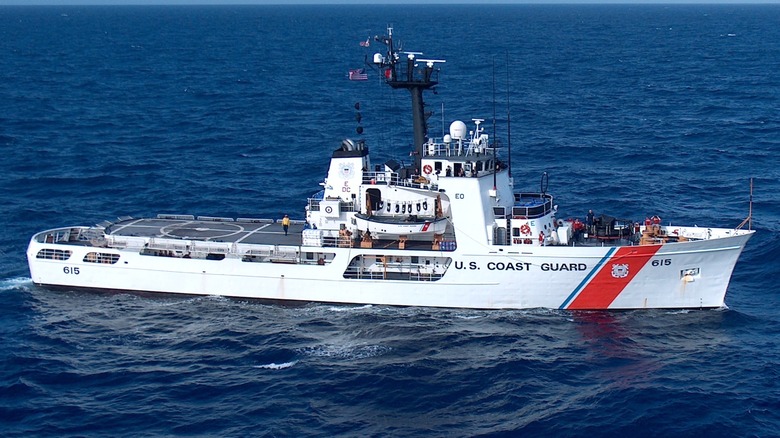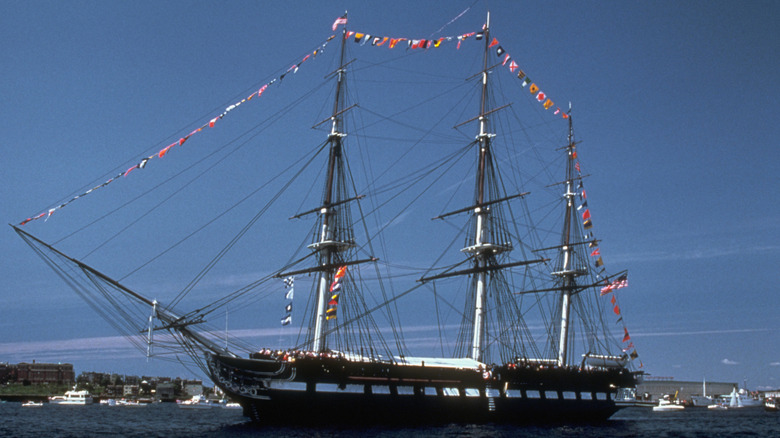5 Of The Oldest Military Ships Still In Active Service Today
When a naval ship has served its purpose or becomes technologically obsolete, it's typically retired or "decommissioned." What usually follows is a scrapping operation, although occasionally a unique warship will be converted into a museum. In most cases, naval vessels don't retain their commission when it comes time to end their service. Still, every once in a while, a navy will keep using a vessel long past its intended retirement.
There are a few naval ships out there that were first built more than 50 years ago. While there are older sailing vessels still afloat among the world's navies that are used for training personnel, the focus of this article is on active military ships that are still technically capable of deploying and fighting. Of course, some of the older examples aren't suitable for modern combat despite their ability to remain afloat, but they remain active commissioned vessels nonetheless.
USS Nimitz (CVN-68)
The USS Nimitz (CVN-68) was commissioned on May 3, 1975. It's named for Pacific Fleet Commander Chester W. Nimitz of World War II, and she is the first of her class. When she was built, the Nimitz was one of the largest warships ever constructed, and she continues on active service. The Nimitz is a massive vessel displacing 100,000 tons of seawater, and her full complement consists of 3,200 sailors and another 2,480 in her air wing.
While the Nimitz was built more than half a century ago, she finished a Refueling and Complex Overhaul (ROH) in 2001, bringing her systems up to 21st-century standards. Throughout her service history, the Nimitz has participated in several operations, including Operation Eagle Claw, which was the failed rescue of embassy staff in Tehran, Iran. Additionally, the Nimitz partook in the Gulf of Sidra Incident, Operations Desert Storm, Southern Watch, Iraqi Freedom, and Enduring Freedom.
The Nimitz is not only the oldest-serving aircraft carrier still in service for the U.S. Navy, she's also the oldest aircraft carrier in the world. Despite her age, she remains a highly capable vessel with a lethal air force that can be deployed anywhere in the world. Despite this, aircraft carriers have a service life of around 50 years, and in September 2024, the Navy instated a plan to retire the ship in 2026.
USS Blue Ridge (LCC-19)
The USS Blue Ridge (LCC-19) is the first in its class of amphibious command ships and the flagship of the Seventh Fleet. The Navy commissioned her on Nov. 14, 1970, naming her after the Blue Ridge mountains. Several Blue Ridge-class vessels followed and continue to sail, but the Blue Ridge was the first, and she's been in active service for over 50 years. The Blue Ridge's role is to provide command, control, communications, computers, and intelligence (C4I) in support of the commander of the fleet. As of October 2024, the USS Blue Ridge is the Navy's oldest deployable warship.
The Blue Ridge displaces nearly 20,000 tons of seawater, and is 634 feet long. Her crew complement consists of 52 officers and 790 enlisted personnel. When she hosts the command staff, these numbers jump to 268 officers and 1,173 enlisted. The Blue Ridge is well-armed for defense, with two Phalanx CIWS guns, two 25 mm Bushmaster cannons, and eight .50 caliber M2 Browning machine guns. She also carries up to two helicopters.
The Blue Ridge served during the Vietnam War, sailing in the Gulf of Tonkin during operations against the North Vietnamese military. During the evacuation of U.S. embassy staff in Saigon, the Blue Ridge was there to assist, helping to take personnel back to the States. After this, she took part in Operation Boat People, helping rescue Vietnamese refugees. In the years since, the Blue Ridge has been primarily used for goodwill port visits and diplomatic engagements.
USCGC Reliance (WMEC-615)
The USCGC Reliance (WMEC-615) is a medium endurance cutter operated by the U.S. Coast Guard since she was first commissioned in 1964. Numerous Coast Guard ships followed in the same class, but the Reliance is the oldest, and she's been operating for over 60 years. While a Coast Guard Cutter isn't a traditional warship, they take part in numerous military operations initiated by the U.S. Coast Guard, including counter-narcotics, pollution patrols, and search and rescue.
The Reliance is just over 210 feet in length, and she displaces 759 tons of seawater. She's crewed by 12 officers and 63 enlisted personnel and is armed with one Mk. 38 25 mm autocannon and two M2HB .50 caliber machine guns. She also carries a single HH-65 Dolphin, which is a type of helicopter used by the Coast Guard for a variety of missions. Interestingly, the Reliance isn't the first naval vessel to bear the name, which goes back to the 19th century.
The Reliance is the fourth to carry this name, and there are no plans to retire her despite her age. You can also track the Reliance, which isn't something you can do with most military vessels. These days, she primarily supports law enforcement operations. This could change, as the Coast Guard falls under the Department of Homeland Defense. It only supports the Department of Defense in full-blown military operations during a time of war.
USS Constitution
The USS Constitution is the oldest ship serving in the U.S. Navy by an epic margin. She was first launched in 1797, and she initially deployed to protect American merchant vessels during the Quasi-War between the U.S. and French First Republic from 1798 to 1800. The Constitution served admirably, earning the nickname "Old Ironsides" in 1812 for shaking off cannonballs in a fight with the HMS Guerriere during the War of 1812. Throughout the conflict, the Constitution defeated several British warships, earning a place of honor and distinction in American history.
While the Constitution was retired from active service, she's never been decommissioned. This makes her the oldest commissioned naval warship afloat. She remained the flagship through much of the 19th century and transitioned into a training vessel during the American Civil War. She was classified as a museum ship in 1907 but remained active in the U.S. Navy. She sailed under her own power to celebrate her 200th birthday in 1997 and did it again in 2012 to commemorate the 200th anniversary of her battle with the Guerriere.
These days, the Constitution remains docked for historical demonstrations and the preservation of naval history. While she is a museum you can visit in Boston, Massachusetts, "Old Ironsides" remains commissioned and has a crew of 75 active duty officers and enlisted personnel. She's not going to join the fight anytime soon, but the fact remains — she's the oldest commissioned warship still serving in the U.S. Navy.
HMS Victory
The HMS Victory is a first-rate ship of the line of the Royal Navy, and she was first launched in 1765. That makes the Victory the oldest naval vessel still in commission. On top of that, the Victory is one of the most historically significant warships in military history, having taken part in several significant conflicts in the late 18th century and the early 19th century. She was famously commanded by Vice-Admiral Horatio Nelson, who used it as his flagship during the Battle of Trafalgar on October 21, 1805, which is her most significant campaign.
The Victory also took part in the first and second Battles of Ushant, the Siege of Gibraltar, the Battle of the Hyères Islands, and the Battle of Cape St. Vincent in the years before Vice-Admiral Nelson took command. Eventually, the Victory's age caught up with her, and she was in dire need of repairs. She was made a second-rate vessel and even served as a prison ship for several years. In 1831, the decision was made to harvest the Victory for her resources, but a public outcry saved her.
She became a sort of museum ship before the designation existed. This resulted in more damage, and in the early 20th century, she underwent repairs and restoration. By the 21st century, the Victory had undergone significant periods of restoration, bringing her back to her glory days. She is now a proper museum ship that's permanently docked so visitors can see the famous vessel for themselves. While she can no longer sail, the Victory retains her commission in the Royal Navy as the flagship of the First Sea Lord and Chief of Naval Staff.





